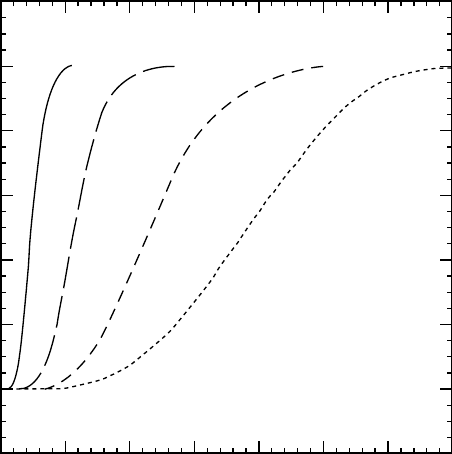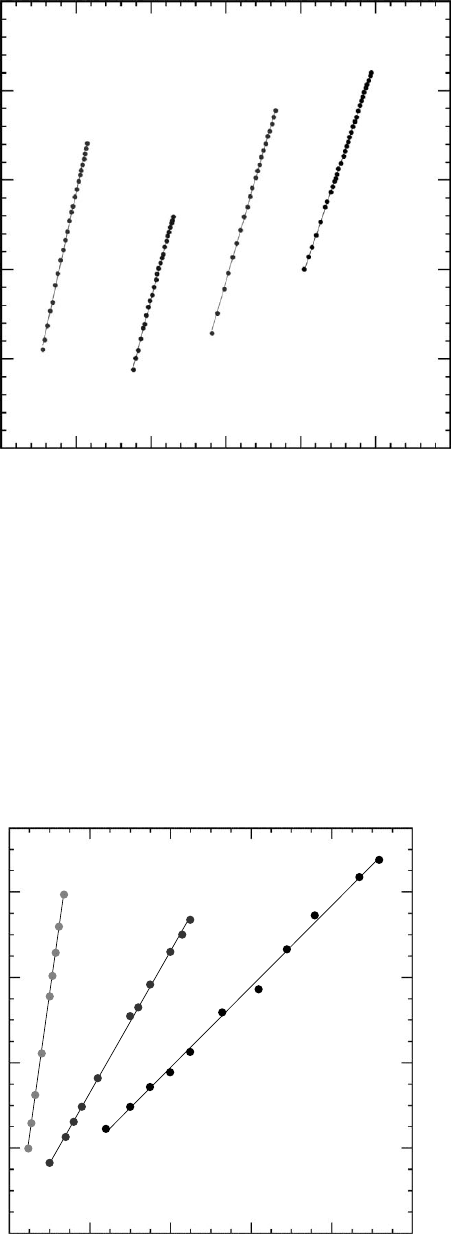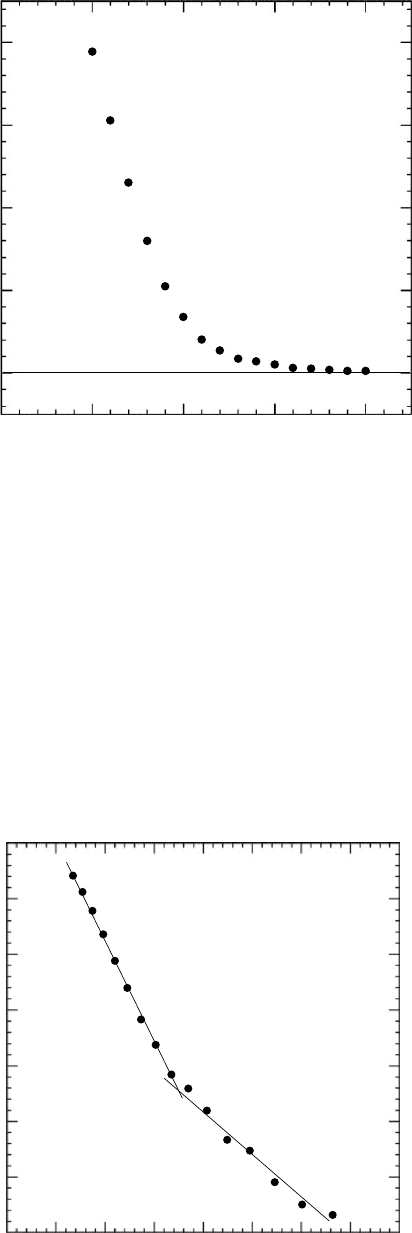Mark James E. (ed.). Physical Properties of Polymers Handbook
Подождите немного. Документ загружается.


g-phase, at the expense of the commonly encountered
a-phase.
For further information on current thinking and theoret-
ical approaches to crystallization, the reader is referred to
recent reviews by Phillips [32,33].
39.1.2 Case Study Using Isotactic Polypropylene
Figure 39.4 shows several chart recorded bulk crystalliza-
tion traces as a function of temperatures for isotactic poly-
propylene (iPP, M
w
¼ 257,000). Avrami’s analysis takes
the lower values of each plot; i.e., before impingement.
The half-time is the point where half of the intensity is
reached. Figure 39.5 presents Avrami’s analysis for differ-
ent crystallization temperatures, where it can be seen that all
plots have similar slope, n, and different intercepts, k,in
this case.
Examples of the change in spherulite radius with time for
selected temperatures are shown in Fig. 39.6, where it
can be seen that linear growth rates result. Plots of growth
rate versus temperature for iPP can be seen in Fig. 39.7.
When the data are analyzed using the Hoffman–Lauritzen
equation, Fig. 39.8, it is seen that iPP shows the Regime
II–Regime III transition, previously identified by several
groups of workers [7–10]. In these analyses the values of
T
0
m
and U
were 186.1 8 C and 1,500 cal/mol, respectively.
The effects of different values of the thermodynamic
variables on the analyses and on the regime transition tem-
perature have been explored. Variation in T
0
m
has the great-
est effect on the shape of the secondary nucleation plot, but
does not significantly alter the regime transition tempera-
ture. A small change of the values of U
and T
g
simply
causes the curve to move up or down without changing its
shape.
The Regime II–III transition is envisioned as the point at
which the rate of surface spreading becomes less than
the rate of secondary nucleation. Surface spreading, for
an adjacent reentry system, is essentially a reeling-in pro-
cess dependent on the reptational ability of the polymer
chain.
The slopes of the secondary nucleation plots can be used
to estimate the fold surface free energies of the two poly-
mers. In order for these calculations to be carried out it
is necessary to have estimates of the parameters which
appear within Eq. 39.5. The equilibrium melting point
has to be determined in separate experimentation (see
Chapter 11).
The values of ss
e
can be determined from the slope of
the lines. Regime II and regime III give ss
e
¼ 562 and
678 erg
2
=cm
4
, respectively. In order to proceed further it is
necessary to estimate s independently. One way to do this is
to use the Hoffman modification of the Thomas–Stavely
relation [24].
s ¼ 0:1Dh
f
ffiffiffiffiffiffiffiffiffi
a
0
b
0
p
: (39:6)
Values of s have been calculated as 11:5 erg=cm
2
for iPP.
Substitution of these values into the determined values of
−0.2
0
0.2
0.4
0.6
0.8
1
1.2
0 5 10 15 20 25 30 35
Light intensity
Time (min)
124 °C 126 °C 132 °C 134 °C
FIGURE 39.4. Isothermal bulk crystallization traces as a function of temperature.
CRYSTALLIZATION KINETICS OF POLYMERS / 629

ss
e
results in values of s
e
for regime II and regime III of
48.9 and 59:0 erg=cm
2
, respectively.
The work done by the chain (q) to form a fold can be
easily calculated from the following equation, when the fold
surface energy is known.
q ¼ 2a
0
b
0
s
e
(39:7)
39.1.3 Tabulation of Data
In the tabulation, data are presented mainly for common
homopolymers. When available, molecular weights are
also given, but no major attempt has been made to present
molecular weight dependencies. Additionally, a few illus-
trations of specific copolymers have been included as
examples of copolymer behavior.
−4
−3
−2
−1
0
1
1234567
ln(− ln(1−
I))
ln(t )
126 °C
132
°C
136
°C
142
°C
FIGURE 39.5. Avrami analyses for different crystallization temperatures.
0
20
40
60
80
0 20406080100
Radius (µm)
Time (min)
130
°C
136
°C
140
°C
FIGURE 39.6. Spherulitic growth of iPP as a function of time for different isothermal crystallization temperatures.
630 / CHAPTER 39

It should be recognized that Avrami data can vary greatly
with the presence of additives, especially nucleating agents.
In Table 39.2 data are presented from bulk crystallization
studies of common polymers.
In Table 39.3 data are presented from linear growth
rate studies of polymers that are commonly encountered
in significant basic studies or that are of commercial signifi-
cance. In addition to the values of the characteristic param-
eters obtained from the analyses, we have added the value of
other constants such as equilibrium melting points and heats
of fusion which are essential to the analyses.
0
10
20
30
40
110 120 130 140 150
G (µm/min)
T
c
(°C)
FIGURE 39.7. Growth rates of iPP versus crystallization temperature.
6
7
8
9
10
11
12
13
3.5 4 4.5 5 5.5 6 6.5 7 7.5
T
∆
= 138.0 ˚C
ln(G ) + U
*/R (T
c
−T
∞
)
(10
5
)/(T
c
−
∆Tf )
FIGURE 39.8. Secondary nucleation analyses of iPP using T
0
m
of 186.1 8C.
CRYSTALLIZATION KINETICS OF POLYMERS / 631

TABLE 39.2. Avrami coefficients.
Polymer
M
n
(kg/mol)
M
w
(kg/mol)
T
c
(8C)
t
1=2
(s) n
k
(s
n
) Remarks Ref.
194.8 43 2.5 DSC [34]
16.0 29.0 197.4 75 2.9
200.4 110 3.6
202.6 200 4.0
Nylon 6
205.5 350 4.8
140 10 3 DLM [35]
24.7 160 15 3
180 70 3
200 950 3
Poly (amide)
( min
n
) DSC [36]
165 46.2 2.21 1:34 10
4
Nylon 10 12
167 68.4 1.97 1:54 10
4
169 144.6 1.91 5:37 10
5
171 241.8 1.91 1:90 10
5
173 450 2.08 1:86 10
6
( min
n
) DSC [37]
164 10.3 1.6 1:23 10
1
Nylon 11
166 16.5 2.1 1:0 10
1
168 23.1 2.4 6.92
170 43.8 2.7 1.62
172 85.8 3.2 2:2 10
1
( min
n
) DSC [38]
Nylon 12 12
160 34.8 2.03 2.12
164 63.6 1.67 6:2 10
1
168 119.4 1.68 2:2 10
1
170 231.6 1.64 8:0 10
2
70 60 DLM [39]
Poly (butene-1) PB-1 73 750 80 96
90 456
95 1572
40 4.5 3.46 DSC [40]
Poly (e- PCL 43.6 48 45 17.9 3.35
caprolactone) 47 45.8 2.48
49 97.6 2.66
Poly (chlorotri- 180 180 3 Dilatometry [41]
fluoroethylene) PCTFE 186 480 3
191 1500 3
196 4200 3
124 165 2.35 DSC [42]
125 338 2.29
126 750 2.05
Polyethylene
HDPE
127 1920 2.24
117 0.24 3.1 DLM [43]
12.7 42.3 119 0.67 2.9
121 4.00 3.0
123 20.00 2.7
Polyethylene XLPE cross- 4.5 8.7 119 3.5 2.7 [43]
link 255 avg 120 1.25 2.2
CH
2
units 123 3.5
124 3.6
632 / CHAPTER 39

TABLE 39.2. Continued.
Polymer
M
n
(kg/mol)
M
w
(kg/mol)
T
c
(8C)
t
1=2
(s) n
k
(s
n
) Remarks Ref.
175.2 4.7 1:6 10
8
DSC [44]
Poly (aryl-ether– PEEK 182.3 5.7 4:7 10
10
ether–ketone) 188.8 5.1 1:8 10
7
( min
n
)
180 2.36 1:02 10
2
DSC [45]
19 40 190 2.30 7:43 10
3
200 2.43 2:04 10
3
Poly (ethylene- PET 210 2.37 2:63 10
4
terephthalate) 190 63 1.83 DSC [46]
195 86 1.76
200 133 1.77
210 190 1.76
185 150 2.61 1:52 10
6
DSC [47]
Poly (propylene- PPT 36.3 78.4 190 250 2.59 4:03 10
7
terephthalate) 195 500 2.61 6:51 10
8
200 1,000 2.48 2:42 10
8
180 50 75 2.47 5:61 10
5
DSC [47]
Poly (butylene- PBT 36.6 77.4 185 150 2.49 1:65 10
5
terephthalate) 190 340 2.48 2:74 10
6
195 2.55 2:79 10
7
2.3 ( min
n
)
170 2.6 3.0 7.9
43 180 2.9 3.2 3.67
190 0.43 DSC [48]
200 9:96 10
3
Poly (trimethylene
ter-ephthalate)
PTT 210 5:75 10
6
( min
n
)
21.05 46.3 202 174 2.81 33:7 10
3
206 279 2.72 10:8 10
3
DSC [49]
210 592 2.84 1:0 10
3
38 23,400 [50]
33 1,440
cis-PIP 22 9,000 [51]
16 12,000
11 19,800 [52]
Poly (isoprene) 5 55,200
35 768
40 1,260
trans-PIP 45 6,780
51 31,800
57 2,91,000
40.1 1.9 0:18 10
1
DSC [53]
Poly (oxyethylene) POE
9.0 9.6 43.4 2.0 6:8 10
1
48.4 2.3 2:6 10
2
49.6 2.1 8:3 10
4
55 612 1.8 DSC [54]
20 56 1,200 1.9
57 1,476 2.0
58 4,884 2.1
59 6,900 2.5
CRYSTALLIZATION KINETICS OF POLYMERS / 633

TABLE 39.2. Continued.
Polymer
M
n
(kg/mol)
M
w
(kg/mol)
T
c
(8C)
t
1=2
(s) n
k
(s
n
) Remarks Ref.
40.3 1,650 3.0 DLM [55]
Poly POP 300 42.8 2,520 3.1
(oxypropylene) 45.5 3,540 3.3
47.5 8,580 3.0
49.7 12,600 3.1
230 160 1.84 DSC [56]
Poly (phenylene PPS 235 195 2.14
sulfide) 240 370 2.12
245 580 2.08
130 430 3.11 1:29 10
3
DLM [57]
58.0 151 132 650 2.61 7:59 10
4
136 3,200 2.84 1:41 10
4
142 13,500 2.91 1:15 10
5
Polypropylene iPP 130 780 3.1 DLM [58]
447 133 2,220 2.9
134 2,820 2.9
137 6,600 2.9
60 100 2.68 1:06 10
1
DSC [59]
76.2 165 70 118 2.68 6.66
80 210 3.07 8:82 10
1
90 684 2.96 3:11 10
2
Polypropylene sPP 95 1,698 2.41 1:33 10
2
75 56 2.44 4:72 10
1
DSC [59]
52.3 195 80 100 2.33 1:24 10
1
90 439 2.40 3:43 10
1
95 1,294 2.32 3:40 10
2
80 32,400 2.01 1: 05 10
2
[60]
Selenium 100 3,600 1.68 0:61 10
1
120 720 3.28 1:20 10
2
dynamic
140 280 3.68 3:60 10
4
density
160 105 4.00 2:60 10
6
148 163.2 2.67 4:16 10
2
Poly POM 149 316.2 2.59 9:48 10
2
DSC [61]
(oxymethylene) 150 607.8 2.36 3:17 10
3
151 1,141.2 2.98 1:08 10
4
296 0.057 0.96 1:21 10
1
Poly (tetrafluoro- PTFE 304 0.116 1.01 5.97 DSC [62]
ethylene) 312 0.332 1.006 2.09
315 0.301 0.87 1.97
236 16.73 1.9 4:76 10
2
Polystyrene sPS 91.6 220 239 50.21 1.4 5:29 10
1
DSC [63]
242 96.33 1.3 2:26 10
1
244 135.14 1.1 1:60 10
1
( min
n
)
192 2,400 2.73 3:05 10
7
Poly (arylene-ether– 34 200 4,800 2.8 4:13 10
8
ether–phenylsulfide) 211 30,000 2.8 9:23 10
9
DSC [64]
218 60,000 2.73 2:27 10
9
226 600,000 2.73 1:69 10
10
634 / CHAPTER 39

TABLE 39.2. Continued.
Polymer
M
n
(kg/mol)
M
w
(kg/mol)
T
c
(8C)
t
1=2
(s) n
k
(s
n
) Remarks Ref.
( min
n
)
Poly (arylene- 19.1 279 5,400 1.7 2:75 10
5
ether–ether– 285 30,000 1.7 1:01 10
5
DSC [64]
biphenylsulfide) 290 48,000 1.9 1:37 10
6
110 19.2 2.52 6:25 10
4
Poly 120 91.8 3.06 0:8 10
6
(ester–amide) 130 2,124 2.71 7:4 10
10
DSC [65]
135 3,180 2.20 1:31 10
8
29 18 3.1 8:9 10
5
Poly (butylene PBA 7.3 35 42 2.6 4:2 10
5
adipate) 40 180 3.0 1:2 10
7
DSC [66]
43 486 3.1 3:3 10
9
45 1,156 3.1 45 10
10
70.2 1272 2.9 6:9 10
10
Poly (butylene PBIP 13 80.2 630 2.9 5:3 10
9
DSC [66]
isophthalate) 90.2 498 2.8 1:9 10
8
100.2 456 3.0 7:3 10
9
109.7 672 3.0 2:3 10
9
118.7 1,068 3.1 2:8 10
10
123.7 1,590 2.9 3:6 10
10
( min
n
)
180 408 2.4 7:1 10
3
Poly (ethylene PEN 190 270 2.9 8:6 10
3
(DSC) [67]
naphthalate) 200 174 2.7 3:8 10
2
210 186 3.2 2:0 10
2
220 204 3.1 1:6 10
2
230 384 2.3 9:2 10
3
240 1,507 2.39
Polyimide* 260 600 2.37 (DSC) [68]
280 444 2.3
300 600 2.32
320 1,197
( min
n
)
147 192 2.9 1:88 10
2
Poly (vinylidene PVDF 170 151 720 2.9 3:12 10
4
(DSC) [69]
fluoride) 153 960 3.1 1:28 10
4
155 1,800 2.9 1:83 10
5
( min
n
)
176 97.8 3.2 1:45 10
1
1, 2-Syndiotactic 1, 2-sPB 177 126 2.8 8:68 10
2
(DSC) [70]
Polybutadiene 178 169.2 3.0 3:09 10
2
179 223.8 2.8 1:74 10
2
180 358.2 2.9 3:9 10
3
*Polyimide synthesized from 3, 3’,4,4’-benzophenonetetracarboxylic dianhydride (BTDA) and 2, 2-dimethyl-1, 3-(4-amino-
phenoxy) propane (DMDA).
CRYSTALLIZATION KINETICS OF POLYMERS / 635

TABLE 39.3.
Growth kinetics coefficients.
Polymer
M
n
(kg=mol)
M
w
kg=mol
T
g
(
C)
T
m
(
C)
DH
f
(J=g)
Growth
face
a
0
(A
˚
)
b
0
(A
˚
)
U
(cal=mol)
Regime
T
rt
(
C)
G
0
(cm=s)
K
g
=10
5
(K
2
)
s
(erg
=cm
2
)
s
e
(erg=cm
2
)
q
(kcal
=mol)
Ref.
Poly(amide)
Nylon 6
30 232.0
4.78 3.70 1,430
0:65
10
1
1.74
118 6.0 [71]
24.7
10 230 10.8
(kcal/mol)
4.78 3.70 1,840
1:05 10
5
6.70 8.0 65
[72]
Nylon 66
45.0 272 200.8
4.76 3.70 167
1:55 10
3
1.02 8.0 40
[72]
Nylon 11
41.96 202.8 217
:9
(J=cm
3
)
(100) 5.4 4.44 1,500 II
1.66 10.6 110.6 7.61 [37]
Poly(butene-1)
PB-1
54:2 127.8
1,500
0:25 10
1
0.79
[71]
Poly(e-
caprolactone)
PCL
26 40
60 70.3 163
(J=cm
3
)
(110) 4.52 4.12 1,500
0.80 6.7 94.7 5.06 [73]
43.6 48
63 74 148
(J=cm
3
)
(110) 4.50 4.10 1,500
6:03 10
1
0.91 6.1 106
[40]
Poly(chlorotrifluoro
ethylene)
PCTFE
52.0 224.0
6.50 5.60 4,000
6:50 10
4
1.72
53 5.6 [71]
400
52 224 91
:1
(J=cm
3
)
6.50 5.60
0:17 10
5
0.17 5.2 36 3.8 [74]
Polyethylene
PE single
crystals
30 63
42 114 280
(J=cm
3
)
(110) 4.15 4.55 1,500 I
2.11 13.7 93.4 5.1 [3]
PE
30.6
42:2 144.6 280
(J=cm
3
)
4.55 4.15 1,500 I
4:40 10
9
2.16 14.1 90.4 5.0 [71]
II 127 2
:24
10
3
1.15 14.1 97.8
20 141 280
(J=
cm
3
)
(110) 4.45 4.11
16:00 10
5
1.24 12.2 49 2.6 [74]
HDPE
13.0 18.1
40:0 144.5 288.7
1,500 I
1:45
10
13
11.8 105.6
[32]
II 125.3 1
:91
10
7
11.8 111.8
[75]
HDPE-NBS 66.4 74.4
144.7
(110)
5,736 I
1:4 10
10
1.98
standard,
II 128.9 1
:02 10
3
0.94 11.8 90
[18]
fractionated
III 120.9 1
:65 10
7
1.85
HDPE,
53.9 101.3
83 142.7
(110)
1,500 I
[19]
un-
II 125.6
fractionated
III 120.8
4 branches/ 16.1 23.6
40:0 143.7 256.3
1,500 I
3:63 10
11
11.8 88.3
1,000 CH
2
II 124.1 8
:91
10
7
11.8 122.0
[25]
22 branches/ 15.2 17.5
40
:0 139.2 212.5
1,500 I
6:45
10
15
11.8 86.0
[25]
1,000 CH
2
II 123.1 8
:51
10
6
11.8 79.0
Poly (3-hydroxybutyrate) PHB
133 358 2 197 146 (100)
2,450 II
4.99
38
[76]
III 130
2.47
[77]
14.1 38.6 143.0 395.0
(200) 4.86 4.68 3,980
165.0
12.1 25.1
[78]
& (110)
[79]

Polymer
M
n
(kg=mol)
M
w
kg=mol
T
g
(
C)
T
m
(
C)
DH
f
(J=g)
Growth
face
a
0
(A
˚
)
b
0
(A
˚
)
U
(cal=mol)
Regime
T
rt
(
C)
G
0
(cm=s)
K
g
=10
5
(K
2
)
s
(erg=cm
2
)
s
e
(erg=cm
2
)
q
(kcal=mol)
Ref.
Poly(aryl-ether–
PEEK
60.2 79.5 150.6 404.0 130
4.68 4,140
18.20 38.0 101
[80]
ether-ketone)
30.9 39.2 148.6 401.2 130
4.68 4,560
12.60 38.0 65
[80]
14.5 18.0 145.3 395.0 130
4.68 4,560
9.8 38.0 45
[80]
144.0 395.0 130 (110) 4.68
2,000
38.0 49.0
[78]
Poly(ethylene-naphthalate
2, 6 dicarboxylate)
PEN
48
300 190
6.51 5.66
60
[81]
19.0 37.0 70 280 140 (100)
4.56 5.53 2,000
10.2 190 13.1 [82]
80 343 135 (010) 5.07 2,000
36 93
[78]
Poly(ethylene-
PET
21.0
80 278 1
:8 (100) 4.56 5.53 3,050 II
10.5 255
[83]
terephthalate)
(J=cm
3
)
III 165
12.8 10.5 301
19–39
67 300
1,544
9.42
[12]
Poly(trimethylene-
PTT
43
45 252 28.8 (010) 4.637 5.71
2,500 I
7.3
84.9 6.5 [48]
terephthalate)
(kJ/mol)
II 215
3.5 19.2 81.3 6.2
III 195
8.4
98.8 7.5
Poly(isoprene)
cis-PIP
262 351
72 35.5
1,500 I
2.63 14.0 21.6
[84]
II
1.50 14.0 24.6
III
2.80 14.0 22.9
344 543
72 35.5
1,500 II
1.28 14.0 21.0
[84]
III
2.46 14.0 20.1
512 897
72 35.5
1,500 III
2.47 14.0 20.3
[84]
cis-PIP
a
-form
(100) 6.23
9.16 23.9 2.13 [85]
cis
-PIP
b
-form
(120) 4.19
5.99 50.3 3.45 [85]
trans
-PIP
170
62:2 87.0
5.87 3.95 1,500
1:10
10
3
2.17
109 7.3 [71]
165 390
59 74 3,040
(cal/mol)
285
(cal/mol)
1,175
(cal/mol)
27.2 [86]
Poly(oxyethylene)
POE
12.0 9.97
66.2 230
(J=cm
3
)
(100) 4.6
3.4 65
[87]
150
67:2 75.2
4.67 4.65 1,500
1:15 10
5
0.81
37 2.3 [71]
POE from 307 325
67:2 69.0 231
4.67 4.65 2,000 I
15:00 10
5
1.18 10 64.33
[88]
solution
(J=cm
3
)
II 53.0
0.60 10 65.59
Poly(oxymethylene)
POM
60:2 186.0
4.53 3.86 1,500
1:28 10
1
1.27
61 3.0 [71]
211 221
(J=cm
3
)
4.46
14.3 150
[89]
Poly(oxypropylene)
POP
73:2 75.0
4.67 5.20 1,320
0:296
10
1
0.785
43 3 [71]
Poly(pivalolactone)
PPVL
3 269 183 (12
¯
0) 7.8 5.7 1,500 II
1:50 10
2
4.32 30 58.1
[90]
(J=cm
3
)
III 203 4
:30 10
8
8.59 30 58.4
Poly(
p-phenylene
PPS
34 51 92 315 80 (020)
4.33 5.61 1,400 II
5.43 8.84 16.9 125 8.9 [26]
sulphide)
III 208 3
:86
10
4
18.35 16.9 130

TABLE 39.3.
Continued.
Polymer
M
n
(kg=mol)
M
w
kg=mol
T
g
(
C)
T
m
(
C)
DH
f
(J=g)
Growth
face
a
0
(A
˚
)
b
0
(A
˚
)
U
(cal=mol)
Regime
T
rt
(
C)
G
0
(cm=s)
K
g
=10
5
(K
2
)
s
(erg
=cm
2
)
s
e
(erg=cm
2
)
q
(kcal
=mol)
Ref.
Polypropylene
iPP
350
12
209 (110) 5.49 6.26 1,500 II
3
:40 10
1
11.5 62.3
[91]
186.1
(040) 6.56 5.24
III 138 3
:98 10
3
72 257
12 186.1 165 (110) 5.49 6.26 1,500
II
3:45 10
1
1.365 11.5 48.1
[92]
III 138.0 3
:03 10
4
3.659 11.5 59.0
300 600
3:4 185.0 8.3 (110) 5.49 6.26 1,500
II
1.250 11.5 51.3 5.07 [93]
(kJ/mol)
III 137
2.554 11.5 52.3 5.19
15 25.5
6:0 170.0 8.3 (110) 5.49 6.26 1,500
I
2.996 11.5 63.5 6.28 [93]
(kJ/mol)
II 133
1.607 11.5 68.2 6.74
III 122
3.196 11.5 67.7 6.69
sPP 76.2 165
6:1 168.7 177 (010) 7.25 5.60 1,500
III 110 9
:07
10
4
5.69 11.28 124.5 14.6 [59]
(J=cm
3
) (200) 5.60 7.25
11.28 96.2 11.2
(020) 7.25 5.60 1,500 II
7.52 1.61 11.27 70.7 8.3
[94]
(200) 5.60 7.25
11.28 54.6 6.4
Polystyrene
iPS
90.5 242.0 91
:1
(J=cm
3
)
12.8 5.5 1,560 II
1.20 7.64 34.8 7.1 [3]
9:1
(J=
cm
3
)
(110) 12.8 5.5
1:31
10
1
5.3 28.8
[95]
sPS 91.6 220 100 278.8
57:5 (040) 4.41 7.2 1,500 II
1.58 3.24 48.15 4.11 [63]
(J=cm
3
)
III 239
3.67 3.24 56.5 4.87
Poly(tetramethyl- PPSS
56
24:0 153.8
6.43 6.41 990
2:16
10
1
1.14
34 4.0 [71]
p
- silphenylene)-
siloxane
or TMPS 286 372
24:0 152 20.8
6.41 1,230
1:03 10
1
3.5 36.3
[13–15]
Selenium
26.8 219.2
4.36 3.78 2,180
0:458
10
1
2.53
190 9.0 [71]
Poly(tetrafluor
oethylene)
PTFE
184.6 331 47.4
1,500
0.154
[62]
Poly(arylene-
34
100 292
1,500 II
[64]
ether-ether-sulfide)
III 205
Poly(ester-amide)
21 170
2,800 II
1.63
[65]
III
3.15
Poly(vinylidene
fluoride)
PVDF 170
178 201
(J
=cm
3
)
4.83
9.7 38
[69]
1, 2-Syndiotactic
polybutadiene
1,2-sPB
18 208
1,500 II
48
[70]
Ethylene-octene
139.3
I
[19]
copolymers L
04
a
27.3 59.9
1.500 II 119.5
(random,
III 113.5
metallocene) H
07
a
43.6 94
134.1
1,500 II
III 115.1
L 11
a
21.2 43.7
134.9
1,500 II
III 114.2
